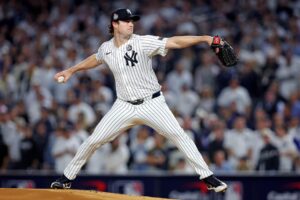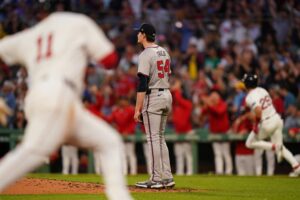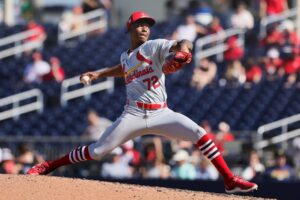Moving along to the next installment in our “Reliving History” Series, the focus shifts to the Midwest for a look back at 1967 St. Louis Cardinals. 1967 marked the Cardinals 86th season playing in St. Louis. Furthermore, it was the team’s first season playing at Busch Memorial Stadium.
Reliving the 1967 St. Louis Cardinals
Under the guidance of skipper Red Schoendienst, the Cardinals compiled a 101-60 record during the regular season. That was good enough for a first place finish in the National League along with a ticket to the World Series. Together as a team, the they accumulated a +138 Run Differential with a Team ERA of 3.05. On the offensive side, St. Louis had a team slash line of .263/.320/.379 along with an OPS+ of 101.
In the lineup and on the pitching staff, there were a couple of star-studded names. Below we’ll dive deeper into those individuals and some of the other role players for St. Louis.
Lou Brock and Orlando Cepeda
The two biggest names in the Cardinals lineup were left fielder Lou Brock and first baseman Orlando Cepeda. Brock and Cepeda were separated in the Cardinals lineup, but both position players had big years for St. Louis.
Right in the middle of his prime at 28 years old, Brock, the left-handed hitting leftfielder concluded the regular season batting: .299/.327/.327 over a career-high 724 plate appearances. Brock was talented at the plate, but really stepped up his game on the base paths, stealing 58 bases.
In addition, that year Brock earned his first career All-Star nod and finished seventh overall in NL MVP Award voting. While the entire season was kind to Brock, it was in September and October that he really stepped up his offensive abilities. During those two months alone, Brock put up a .371/.426/.619 slash line over 26 games. In that span, Brock had 39 hits, 2 doubles, 3 triples, 6 home runs, 16 RBI, 12 stolen bases, 10 walks, and 17 strikeouts.
As for Cepeda, the right-handed hitting first basemen and future Hall of Famer won NL MVP Award honors. Cepeda concluded the regular season hitting .325/.399/.524 over 644 plate appearances with an astounding 111 RBI. That was still a fry cry from Cepeda’s 1961 RBI amount of 142 though!
St. Louis originally acquired Cepeda from the San Francisco Giants in May of 1966 in exchange of left-handed pitcher Ray Sadecki. Cepeda definitely made his presence known over his tenure in the Gateway to the West. More specifically, one area where Cepeda really excelled in 1967 was hitting with runners in scoring position (RISP). Cepeda, accumulated 186 plate appearances that were considered RISP situations, and hit .380/.505/.577 over that sample.
Brock and Cepeda in the Postseason
Once the calendar turned to October and the World Series, it was really a tale of two different Fall Classics for both players. For Brock, the World Series was phenomenal as the outfielder really took his game to another level. For Cepeda, the Fall Classic wasn’t nearly as kind.
During the seven-game World Series, Brock hit .414/.452/.655 over a sample of 31 plate appearances. In that sample, Brock accumulated 12 hits, two doubles, one triple, one home run, three RBI, seven stolen bases, and two walks. In contrast, Cepeda racked up 29 plate appearances in the World Series. Over that span, Cepeda hit .103/.103/.172. Quite the stark difference between both batting lines.
Other Role Players in the Lineup
While it’s easy to pay a lot of attention to Brock and Cepeda when looking back on that season for the Cardinals, there were other key role players in the lineup as well. One of those individuals was catcher Tim McCarver. McCarver concluded the regular season with a .295/.369/.452 slash line over 540 plate appearances. Over that sample, McCarver tallied 14 home runs, 69 RBI, and 54 walks. He recorded 32 strikeouts for a minuscule 5.9% strikeout rate.
Although impressive, McCarver’s worth was really felt behind the dish from a defensive perspective. That season, the left-handed hitting catcher compiled a Caught Stealing Percentage (CS%) of 55%. That was well above the league average that year which sat at 40%. In total, McCarver had a .997 Fielding Percentage that year. Combining his contributions together, it resulted in McCarver’s final All-Star nod and a second place finish in NL MVP Award voting.
Furthermore, from a pure power perspective credit has to be given to centerfielder Curt Flood. The then 29-year old outfielder concluded the season with a Gold Glove award and 13th place finish in NL MVP Award voting. Over the regular season, Flood registered a .793 OPS along with a Runs Above Average (RAA) value of 27. In total, that translated to a Wins Above Replacement value of 5.3, which was the second highest WAR value of Flood’s 15-year big league career.
In addition, right fielder Roger Maris deserves mention as well. Maris was winding down in his big league tenure and the 1967 season was the last year in which Maris played in more than 100 games. He finished the season with a .346 On-Base Percentage and a Slugging Percentage of .405 over 125 games. He did particularly well against the San Francisco Giants that year. Over 11 games against the Giants, the outfielder hit .324/.410/.412 with a Batting Average on Balls In Play (BABIP) of .344.
“Gibby” The Ace
When looking back on any of the Cardinals teams from the 1960s and early-to-mid 1970’s, no conversation is complete without a heavy focus on right-hander Bob Gibson. Gibson, who pitched in his age 31 season in 1967, finished the regular season with a 2.98 ERA over 175 and 1/3 innings of work. In that span, Gibson compiled a 2.34 Fielding Independent Percentage (FIP), 1.089 WHIP, and a 7.5 K/9 rate. Additionally, Gibson pitched 10 complete games that season.
Gibson won both a Gold Glove award and All-Star nod from his contributions that year. Although Gibson was very successful over the span of the whole season, the second half was where the future Hall of Famer really shined. In that span, Gibson held opposing batters to a .194/.252/.215 slash line. While it was only over six games, it’s still very impressive and worthy of a mention. From an ERA perspective, that translated to a 1.11 ERA over those six games with 29 strikeouts.
The reason Gibson only made six starts in the second half was due to a broken fibula that he suffered following a line drive off of the bat of Pittsburgh Pirates right fielder Roberto Clemente. However, the injury did not keep Gibson sidelined for long especially when it came to what happened once the World Series rolled around.
Easily the biggest reason why the Cardinals won the World Series was because of Gibson. He came away from the series with MVP honors and built himself a nice postseason resume on the big stage. Gibson made three starts in the Fall Classic posting a 1.00 ERA over those three starts and the best part was they were all complete games.
Carlton & Hughes Formidable Starting Duo
During his first full season at the big league level, left-handed pitcher Steve Carlton came out in a big way. The then-22-year old and future Hall of Famer made 30 starts, putting up a 2.98 ERA. In those 30 starts, he compiled a 2.47 FIP, 1.218 WHIP, and 168 strikeouts. During the regular season, Carlton recorded 11 complete games.
During the Fall Classic, Carlton made one start. In that start, the lefty pitched six innings and faced 24 batters, while compiling a 0.833 WHIP and recording five strikeouts. A critical play during that Game 5 start was a double play that Carlton started against Boston during the sixth inning.
Additionally, the contributions from right-hander Dick Hughes were significant as well. Hughes, whose big-league career was very short, pitched 12 complete games for St. Louis that season. In addition, Hughes started 27 games, finished six matchups, and recorded three shutouts over that span.
Over the 37 games that Hughes pitched in that season, the righty posted an ERA of 2.67. Hughes had a very high H/9 Rate of 6.6, but that was matched with an ERA+ of 123 and a WHIP of 0.954. From a WAR perspective, that translated to almost five wins for the Cardinals (4.2 to be exact) and a Runs Better Than Average (RAA) value of 18.
Hughes struggled come the World Series over the two starts that he made. One those two starts, Hughes posted a 5.00 ERA over nine innings of work with a HR/9 Rate of 5.0 and BB/9 of 3.0. Both starts came on the road at Fenway Park. Following the 1967 Fall Classic, Hughes would finish the 1968 season before pitching in 31 games for the Class-A St. Petersburg Cardinals the following year at the age of 31.
Role Players on the Pitching Staff
Locking down things at the back of the pitching staff was left-hander Joe Hoerner. That season Hoerner concluded the regular season with a 2.59 ERA over 66 innings of work. In that span, the southpaw recorded 50 strikeouts and a 2.96 FIP. Furthermore, Hoerner was really effective at home in Busch Memorial Stadium. Hoerner pitched in 28 games there holding opposing batters to a .187/.246/.252 slash line.
Another important role player on the Cardinals pitching staff that season was right-hander Nelson Briles. Briles pitched in 49 games that year with 14 of those as the closer and also had four complete games. The 1967 season was a career one in many ways for Briles as he concluded the regular season with a 2.43 ERA and a career best win-loss percentage of .737. In total, Briles contributed so much to the Cardinals pitching staff that he finished 15th in NL MVP Award voting. Of course, Briles most well-known moment from that season when his complete game during Game 3 of the World Series.
Additionally, Ron Willis is yet another pitcher for St. Louis that deserves credit. Willis was 23-years old that season and like Nelson Briles, it was a career year for the right-hander. Willis pitched in 65 games with 24 of those as the closer and posted a 2.67 ERA. However, it wasn’t a smooth ride the entire 161-game season for Willis. During the first half of the season, Willis had a 4.50 ERA over 36 innings of work and held opponents to a .292 Batting Average Against. In contrast, once the second half of the season came around, Willis posted a 1.20 ERA over 45 innings of work with a .226 OBAA.
World Series Recap
If the 1967 World Series could be concluded in one word, it would be “complete game.” The entire St. Louis Cardinals pitching staff was on point and the aforementioned Bob Gibson really shined in a big way. The saying is that pitching and defense wins championships and the pitching end of that statement is where the Cardinals really came through.
Besides the pitching, Lou Brock put on a dominant display and showed the rest of baseball how to steal a base when it matters most. Brock was a prototypical leadoff hitter for that era of baseball and it really showed that October.
While the 1967 St. Louis Cardinals came out on top as champions against the Boston Red Sox, it wasn’t an easy seven-game series. Boston was relentless and were very hungry to win a championship following a 49-year championship drought. For St. Louis, the 1967 World Series wasn’t the only Fall Classic the team would play in during the 60’s. They defeated the New York Yankees in 1964, but they lost to the Detroit Tigers in 1968. Both were seven-game series, as well. It wouldn’t be until 1982 that the Cardinals added another World Series Championship to their franchise story.
1967 St. Louis Cardinals Main Photo:






